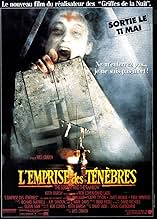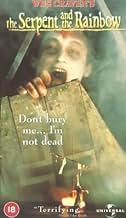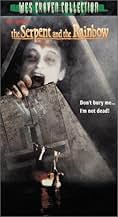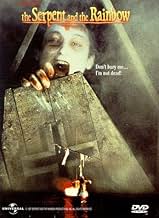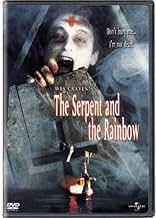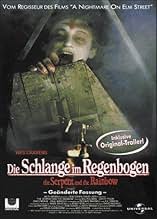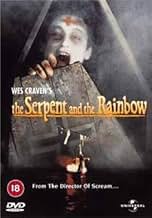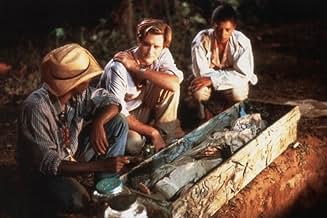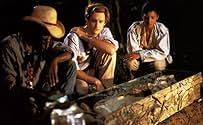IMDb रेटिंग
6.4/10
29 हज़ार
आपकी रेटिंग
एक मानवविज्ञानी लोगों को लाश में बदलने के लिए काले जादू चिकित्सकों द्वारा उपयोग की जाने वाली दवा के बारे में अफवाहें सुनने के बाद हैती जाता है।एक मानवविज्ञानी लोगों को लाश में बदलने के लिए काले जादू चिकित्सकों द्वारा उपयोग की जाने वाली दवा के बारे में अफवाहें सुनने के बाद हैती जाता है।एक मानवविज्ञानी लोगों को लाश में बदलने के लिए काले जादू चिकित्सकों द्वारा उपयोग की जाने वाली दवा के बारे में अफवाहें सुनने के बाद हैती जाता है।
- पुरस्कार
- कुल 1 नामांकन
Jaime Pina
- Julio
- (as Jaime Piña Gautier)
Kimberleigh Aarn
- Margrite
- (as Kimberleigh Burroughs)
फ़ीचर्ड समीक्षाएं
In 1985, after a successful research in Amazonas, Dr. Dennis Alan (Bill Pullman) from Harvard is invited by the president of a Boston pharmaceutics industry, Andrew Cassedy (Paul Guilfoyle), to travel to Haiti to investigate the case of a man named Christophe (Conrad Roberts) that died in 1978 and has apparently returned to life. Andrew wants samples of the voodoo drug that was used in Christophe to be tested with the intention of producing a powerful anesthetic. Dr. Alan travels to meet Dr. Marielle Duchamp (Cathy Tyson) that is treating Christophe and arrives in Haiti in a period of revolution. Soon Alan is threatened by the chief of the feared Tonton Macuse Dargent Peytraud (Zakes Mokae), who is a torturer and powerful witch. Alan learns that death is not the end in the beginning of his journey to hell.
"The Serpent and the Rainbow" is one of the creepiest and most originals zombie movie ever produced. Directed by Wes Craven, the story uses the background of political environment of Haiti and entwines horror and politics. Bill Pullman has good performance and Cathy "Mona Lisa" Tyson completes the romantic pair of the story. But Zakes Mokae "steals" the movie with a scary performance in the role of the wicked Peytraud. My vote is seven.
Title (Brazil): "A Maldição dos Mortos-Vivos" ("The Curse of the Living Dead")
"The Serpent and the Rainbow" is one of the creepiest and most originals zombie movie ever produced. Directed by Wes Craven, the story uses the background of political environment of Haiti and entwines horror and politics. Bill Pullman has good performance and Cathy "Mona Lisa" Tyson completes the romantic pair of the story. But Zakes Mokae "steals" the movie with a scary performance in the role of the wicked Peytraud. My vote is seven.
Title (Brazil): "A Maldição dos Mortos-Vivos" ("The Curse of the Living Dead")
The best thing about "The Serpent and the Rainbow" is probably the topic it covers: Not known to the general public (including me, until I watched the film and researched the subject a little more afterwards), the so-called zombies, which legend has it that they are people who were condemned by sorcerers to become living deads, are in fact nothing more than the victims of a special powder thrown to them, whose active ingredient is a substance which is now well-known by scientists worldwide. This substance has the effect of rendering the person in a dead-like state (no ostensible breathing, moving, etc.), while his brain is still lively (which means that the horrified person is even able to understand what surrounds him, without being able to do anything about it); in such cases, an inexperienced doctor claims the person deceased, and he is then put into a grave. When the effect of this substance starts to diminish after 12-24 hours, the sorcerer is usually there to undig the completely shocked and shattered person, convincing him that he is now his zombie-slave.
The movie is based on a true story by a scientist (Pullman) who went to Haiti, a country were such practices were rife, in order to get his hands on this substance and provide it to his employer, a pharmaceutical company, in order to analyze it and use it as an anaesthetic. In his quest he was assisted by a female local psychiatrist (Tyson), who treated several "zombified" people. However, he soon realized that things were much more complicated than that, as the police chief (Mokae), who used this zombie-trick as one of his suppression tools, was quite unhappy with this intrusion.
Although based on a very interesting story, the movie goes a bit far and becomes a typical horror film, full of black magic, terrifying visions, etc. In my opinion, it would be much better if the plot sticked to the basics, as from some point onwards everything (and especially the ending) becomes too unconvincing.
The cast does a fair job, despite the fact that it includes actors not widely known. The make-up and scenery produce and impressive atmosphere, traveling the viewer to the mystifying secrets of Haiti.
Grade: 7/10.
The movie is based on a true story by a scientist (Pullman) who went to Haiti, a country were such practices were rife, in order to get his hands on this substance and provide it to his employer, a pharmaceutical company, in order to analyze it and use it as an anaesthetic. In his quest he was assisted by a female local psychiatrist (Tyson), who treated several "zombified" people. However, he soon realized that things were much more complicated than that, as the police chief (Mokae), who used this zombie-trick as one of his suppression tools, was quite unhappy with this intrusion.
Although based on a very interesting story, the movie goes a bit far and becomes a typical horror film, full of black magic, terrifying visions, etc. In my opinion, it would be much better if the plot sticked to the basics, as from some point onwards everything (and especially the ending) becomes too unconvincing.
The cast does a fair job, despite the fact that it includes actors not widely known. The make-up and scenery produce and impressive atmosphere, traveling the viewer to the mystifying secrets of Haiti.
Grade: 7/10.
First I have to mention that while the book (The Serpent and the Rainbow by Wade Davis) is infinitely better and deeper than the movie that shares its name, comparing the two is unfair. The audience is informed that the movie was "inspired" by the content of the book, for whatever interpretation you give inspired. What makes the book more interesting, aside from it being a true documentary, is how it balances light and shadow in much the way the Vodoun religion balances both. This film may leave you thinking that Haiti is a horrible place filled with monsters and boogeymen, and I don't think that's a fair estimation.
The film confuses many things and ideas which I feel should have been explained. Not everyone is an ethnoreligionist, after all. Totems, houngans, hounfours, mambos, bokors, le Bon Dieu, and the Amazon shaman are just mentioned in passing as if this is everyday vocabulary to the audience. The character of Marielle is presented as a dedicant of the goddess (loa) Erzulie. Well, this is a nice touch, but what of Damballah and his consort Aida-Wedo--the original serpent and the rainbow? And what about the man dressed as a skeleton in an obvious tribute to Baron Samedi--yet the Baron is never mentioned. What really made me chuckle is how Alan's totem saves the end, a totem we had only seen in glimpses without the concept of a power animal ever being explained.
Through in the confusion of the collapse of the Duvalier government and we have the perfect recipe for movie mayhem. Oh, come on...you just knew the overthrow of Duvalier had to work itself in here somewhere, right? We must have the obligatory "I am an American citizen--you cannot touch me" scene when dealing with the so-called Third World.
Bill Pullman was entirely wrong as the protagonist. I just found it unbelievable that this man could find his way out of a Happy Meal box let alone 200 miles of Amazon rainforest. He is abrasive and unpolite, two things which are professional suicide for anybody dealing in international cultures. All right, one can allow for a certain degree of cynicism on his part, but I find it difficult to believe that a man of his caliber and academic background would be fool enough to shoot his mouth off as he does.
Watch this film with an acrostic eye. It isn't a bad film, in spite of the faults I personally found with it. Just watch it cautiously. If it whets your interest, definitely go check out the Davis book.
The film confuses many things and ideas which I feel should have been explained. Not everyone is an ethnoreligionist, after all. Totems, houngans, hounfours, mambos, bokors, le Bon Dieu, and the Amazon shaman are just mentioned in passing as if this is everyday vocabulary to the audience. The character of Marielle is presented as a dedicant of the goddess (loa) Erzulie. Well, this is a nice touch, but what of Damballah and his consort Aida-Wedo--the original serpent and the rainbow? And what about the man dressed as a skeleton in an obvious tribute to Baron Samedi--yet the Baron is never mentioned. What really made me chuckle is how Alan's totem saves the end, a totem we had only seen in glimpses without the concept of a power animal ever being explained.
Through in the confusion of the collapse of the Duvalier government and we have the perfect recipe for movie mayhem. Oh, come on...you just knew the overthrow of Duvalier had to work itself in here somewhere, right? We must have the obligatory "I am an American citizen--you cannot touch me" scene when dealing with the so-called Third World.
Bill Pullman was entirely wrong as the protagonist. I just found it unbelievable that this man could find his way out of a Happy Meal box let alone 200 miles of Amazon rainforest. He is abrasive and unpolite, two things which are professional suicide for anybody dealing in international cultures. All right, one can allow for a certain degree of cynicism on his part, but I find it difficult to believe that a man of his caliber and academic background would be fool enough to shoot his mouth off as he does.
Watch this film with an acrostic eye. It isn't a bad film, in spite of the faults I personally found with it. Just watch it cautiously. If it whets your interest, definitely go check out the Davis book.
Much to my surprise, this film was actually an excellent horror flick, one that I plan to watch again some day. I am glad a friend of mine recommended the movie to me, I am just hoping others will find the time to look into it.
Even more, if the story actually is based on a "true story", I will shudder at the thought of it...
Even more, if the story actually is based on a "true story", I will shudder at the thought of it...
A researcher (Bill Pullman) goes to Haiti in order to find a "zombie drug" that can give someone the appearance of death, when in actuality their body is at its lowest functioning. They may not breathe, or bleed, but they are not truly dead. The researcher and the company he works for hope to use it as an anesthetic.
The film started as a book of the same name by anthropologist Wade Davis, who is probably the world's authority on voodoo and zombies. Discussions were made to have Peter Weir direct and/or Mel Gibson star, but obviously this never happened. The script found its way to Wes Craven, and Bill Pullman (at that point a young rising star) was given the lead.
Author Wade Davis was on set from the very beginning and wanted to make the best film he could regardless of who the director would be. He notoriously did not like the way it went, and Bill Pullman says that both he (Pullman) and Wes Craven were disappointed, too, because they wanted a more serious angle and the studio (Universal) was pushing for a horror story. In retrospect, Davis seems to have become more accepting of the film and does not hold it against Craven. In fact, he praises many of the scenes for their authenticity, especially in comparison to other attempts at making voodoo films.
The filming took place throughout 1987, and the political tensions were getting nasty in Haiti. Dictator Jean-Claude "Baby Doc" Duvalier becomes part of the plot, which makes this not just an anthropological horror film, but a political one, too. If people are able to look past the horror aspects, there is actually an important cultural document here.
While the film is quite interesting for a variety of reasons, it starts off slow, and does not really pick up until the second half. Bill Pullman's character is the only one you are going to get to know from this film, and the only character who gets a lot of development. The natives seem very flat, and most just come across as wanting to kill Pullman. In a way, this makes sense, because this story is essentially told from his point of view.
Bill Pullman reflected years later, "I don't think any other movie I've done is as adventurous as this one." He did most of his own stunts, met with real voodoo priests and took part in a variety of activities that may not be your typical Hollywood situation. One scene was filmed in an actual Dominican grave. He confirms that writer Richard Maxwell had to be admitted to an asylum after consulting with a voodoo priest.
Fans of Craven ought to check this one out. It does not have the in-your-face slasher horror of Craven's "Nightmare on Elm Street", "Scream" or "Last House on the Left". But it is not intended to be. This is a film built on atmosphere, and in many ways a horror more realistic than any he had ever done before.
As always, the must-have version was released by the fine folks at Scream Factory. Those interested in the movie will have to watch the 25-minute "making of", which has interviews with cinematographer John Lindley, the father-son special effects team of Lance and Dave Anderson, Wade Davis, and some re-used audio from Pullman.
The audio commentary is disappointing. On the one hand, it is the first time the film has had a commentary track, so credit must be given to Scream Factory for giving the disc the attention that past companies (specifically Image and Universal) failed to do. But the commentary with Bill Pullman only goes halfway through the film, with no one left to take his place. The real tragedy is in the passing of Wes Craven (the disc is dedicated to him), who could have offered more insight.
There will undoubtedly never be a better release of this essential Wes Craven film... unless someone manages to convince Bill Pullman to hand over all the vacation footage he shot with his wife on set!
The film started as a book of the same name by anthropologist Wade Davis, who is probably the world's authority on voodoo and zombies. Discussions were made to have Peter Weir direct and/or Mel Gibson star, but obviously this never happened. The script found its way to Wes Craven, and Bill Pullman (at that point a young rising star) was given the lead.
Author Wade Davis was on set from the very beginning and wanted to make the best film he could regardless of who the director would be. He notoriously did not like the way it went, and Bill Pullman says that both he (Pullman) and Wes Craven were disappointed, too, because they wanted a more serious angle and the studio (Universal) was pushing for a horror story. In retrospect, Davis seems to have become more accepting of the film and does not hold it against Craven. In fact, he praises many of the scenes for their authenticity, especially in comparison to other attempts at making voodoo films.
The filming took place throughout 1987, and the political tensions were getting nasty in Haiti. Dictator Jean-Claude "Baby Doc" Duvalier becomes part of the plot, which makes this not just an anthropological horror film, but a political one, too. If people are able to look past the horror aspects, there is actually an important cultural document here.
While the film is quite interesting for a variety of reasons, it starts off slow, and does not really pick up until the second half. Bill Pullman's character is the only one you are going to get to know from this film, and the only character who gets a lot of development. The natives seem very flat, and most just come across as wanting to kill Pullman. In a way, this makes sense, because this story is essentially told from his point of view.
Bill Pullman reflected years later, "I don't think any other movie I've done is as adventurous as this one." He did most of his own stunts, met with real voodoo priests and took part in a variety of activities that may not be your typical Hollywood situation. One scene was filmed in an actual Dominican grave. He confirms that writer Richard Maxwell had to be admitted to an asylum after consulting with a voodoo priest.
Fans of Craven ought to check this one out. It does not have the in-your-face slasher horror of Craven's "Nightmare on Elm Street", "Scream" or "Last House on the Left". But it is not intended to be. This is a film built on atmosphere, and in many ways a horror more realistic than any he had ever done before.
As always, the must-have version was released by the fine folks at Scream Factory. Those interested in the movie will have to watch the 25-minute "making of", which has interviews with cinematographer John Lindley, the father-son special effects team of Lance and Dave Anderson, Wade Davis, and some re-used audio from Pullman.
The audio commentary is disappointing. On the one hand, it is the first time the film has had a commentary track, so credit must be given to Scream Factory for giving the disc the attention that past companies (specifically Image and Universal) failed to do. But the commentary with Bill Pullman only goes halfway through the film, with no one left to take his place. The real tragedy is in the passing of Wes Craven (the disc is dedicated to him), who could have offered more insight.
There will undoubtedly never be a better release of this essential Wes Craven film... unless someone manages to convince Bill Pullman to hand over all the vacation footage he shot with his wife on set!
क्या आपको पता है
- ट्रिवियाNewly wed, Bill Pullman's wife was invited to be an extra and appears on screen as the blonde who pushes a long needle through a willing man's cheek.
- गूफ़At about the 1:05 mark a computer screen shows the word "specimen" misspelled as "speciman".
- भाव
Dennis Alan: Don't let them bury me! I'm not dead!
- क्रेज़ी क्रेडिट[Opening card] In the legends of voodoo the Serpent is a symbol of Earth. The Rainbow is a symbol of Heaven. Between the two, all creatures must live and die. But because he has a soul Man can be trapped in a terrible place Where death is only the beginning. The following is inspired by a true story.
- इसके अलावा अन्य वर्जनUK video and DVD versions are cut by 5 seconds by the BBFC to remove shots of cock-fighting (illegal animal cruelty).
- साउंडट्रैकMadame Marcel
Performed by Le Roi Coupe Cloue
Courtesy of Chancy Records
टॉप पसंद
रेटिंग देने के लिए साइन-इन करें और वैयक्तिकृत सुझावों के लिए वॉचलिस्ट करें
- How long is The Serpent and the Rainbow?Alexa द्वारा संचालित
- What are the differences between the old British BBFC 18 Version and the Uncensored Version?
विवरण
बॉक्स ऑफ़िस
- बजट
- $70,00,000(अनुमानित)
- US और कनाडा में सकल
- $1,95,95,031
- US और कनाडा में पहले सप्ताह में कुल कमाई
- $58,48,700
- 7 फ़र॰ 1988
- दुनिया भर में सकल
- $1,95,95,031
- चलने की अवधि1 घंटा 38 मिनट
- रंग
- ध्वनि मिश्रण
- पक्ष अनुपात
- 1.85 : 1
इस पेज में योगदान दें
किसी बदलाव का सुझाव दें या अनुपलब्ध कॉन्टेंट जोड़ें






